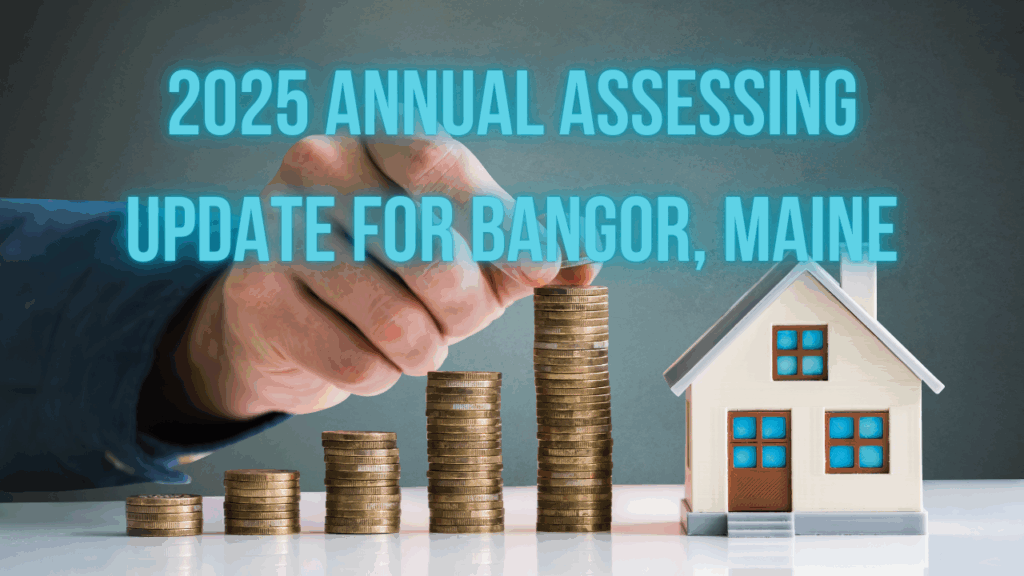
Disclaimer: The views I express here are my own and should NOT be construed as speaking for the City of Bangor or the City Council of Bangor.
The City Assessor’s office just released its annual update, and it’s packed with key information on how your property tax bill is calculated. The full presentation is available on the city’s website, but here are some highlights every homeowner and business owner in Bangor needs to know.
The Big News: The Mill Rate is Going DOWN
Let’s start with the good news. The city’s mill rate is decreasing this year.
- Last year’s rate: $18.55 per $1,000 of taxable value.
- This year’s rate: $17.70 per $1,000 of taxable value.
That’s an 85-cent drop, which is about a 5% decrease. This is the rate used to calculate your final tax bill.
…But Your Assessed Value is Probably Going UP
While the tax rate is lower, the real estate market in Bangor remains strong, and property values are climbing. The city’s goal is for assessed values to be very near market values. Because of this, the city has made adjustments.
Here’s a snapshot of the market:
- The median sale price for a single-family home in Bangor during 2024 was $270,000, a 1.4% increase over the previous year.
- A study of repeat sales showed an annualized appreciation rate of 8.7% for single-family homes and 19.6% for multi-unit apartment buildings.
To keep assessments equitable, the city has implemented citywide increases to assessed values effective April 1, 2025. For example, single-family homes saw a 2% increase on top of any neighborhood-specific adjustments, while buildings with three or more units saw a 10.7% increase plus neighborhood adjustments.
A Fair and Data-Driven Approach
It’s important to remember the assessor’s job isn’t to set tax rates, but to ensure the system is fair and equitable for everyone. The goal is for every property’s assessed value to be very near its actual market value, so the tax burden is distributed properly. To do this, the assessor’s team constantly analyzes sales data to see if properties are valued correctly. A recent study of sales in early 2025 showed a median sales ratio of 87%. The report makes it clear that without the proactive adjustments made by the assessor this year, that ratio would have been down in the high 70s. This data-driven work is crucial for improving equity and making sure assessments follow market trends.
How Your Tax Bill is Calculated
So how do these two numbers—the mill rate and your assessed value—work together? The city provided a clear example:
- Start with your Total Assessed Value: Let’s say your property (land + building) is valued at $250,000.
- Subtract Exemptions: If you have a Homestead Exemption, you can deduct $25,000. This lowers your taxable value to $225,000. (Other exemptions for veterans and legally blind residents are also available) .
- Calculate the Tax: Multiply your taxable value by the new mill rate: 225,000×0.0177=$3,982.50.
The Tax Burden Shift: Who Pays for Bangor?
An interesting trend over the last eight years is the shift in who pays the largest share of property taxes.
- Then: Eight years ago, commercial and industrial properties paid the largest portion of taxes in Bangor.
- Now: Today, residential properties (including 1-4 family homes, condos, and mobile homes) pay the largest share at 48.8%, just edging out the commercial and industrial sector’s 46.3%. The shift really took hold in 2021.
Watch the Full Report!
This is just a summary, and the full presentation dives much deeper into specific neighborhood adjustments, new construction projects, and the local economy. I highly recommend watching it yourself to get the full picture.
You can find the “Annual Assessing Update” on the City Assessor’s webpage (click here).
Stay informed, Bangor!







